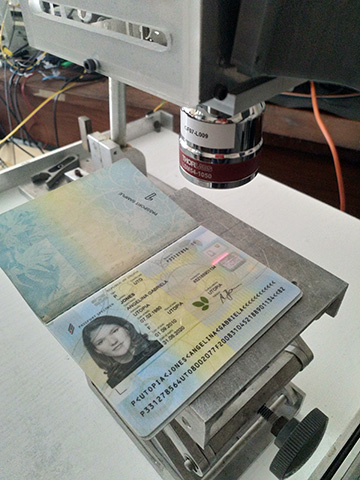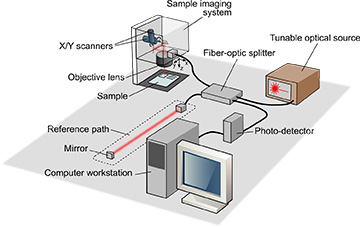
A specimen passport is resolved by the OCT system. [Courtesy of the researchers]
Since first hitting the scene in 1991, optical coherence tomography (OCT) has become a leviathan among biomedical imaging techniques, due to the method’s nondestructive ability to resolve layers of tissue. In ophthalmology, especially, OCT has been revolutionary, imaging retinal layers noninvasively through an approximately one-inch-thick watery window—the human eye.
Now, U.K. researchers in applied optics, forensic science and the document-examination industry have joined forces to apply OCT to the high-resolution subsurface analysis of multilayered identification documents (Sci. Justice, doi: 10.1016/j.scijus.2020.12.001). The method can reportedly detect forged passports or national ID cards in a matter of seconds—without compromising evidence.
Counterfeit catchup
Though spies on TV might make fake passports seem like a dime a dozen, modern passports embed a multitude of sophisiticated security features, sandwiched between several semi-transparent polycarbonate layers of varying thickness. In this way, the security features are found not only in different locations on the document but also at different depths, making them difficult to forge.
However, even as documents like passports and national ID cards have become more and more secure, counterfeiters have also stepped up their game, developing increasingly advanced techniques to produce fakes. For example, a fraudster might use cutting-edge computer technology to reproduce holograms or other security features and relaminate forged papers. Any of these tactics, though, will also affect the inner structure of a document—and that’s where the researchers behind the new study saw a window of opportunity for OCT.
The team, which represents both the applied-optics group and the forensic-science group at the University of Kent and the U.K.-based forensic-examination company Foster and Freeman, recognized this unmet, evolving security need as a chance to demonstrate OCT’s untapped potential in forensic science.
First author Manuel J. Marques at the University of Kent, who works in an applied optics group that has been developing OCT for eye imaging for over 20 years, says that he “jumped” at the chance to develop forensic applications for OCT. “I remain convinced that [OCT] has the potential to revolutionize the existing techniques,” says Marques, “providing a powerful investigative tool for even the most difficult of cases and circumstances.”
Under the surface

This schematic shows the OCT setup for the document-verification experiment. [Courtesy of the researchers]
After obtaining sample documents from an ID manufacturer, Marques and his colleagues analyzed them using a swept-source OCT system. In their setup, light from a tunable laser splits between the reference path and the object path. Once light returns from both paths, it is recombined and detected by a photodetector, creating a 1D depth profile. This information is then combined with data from X/Y scanners to create a 3D representation of the sample.
In this way, the team virtually dissected a specimen passport and national ID card without any physical interaction. OCT’s nondestructive nature, Marques explains, is one of its shining features for forensic applications, as valid documents will remain functional and intact, while forged documents can be examined without compromising evidence, such as fingerprints or DNA.
For example, explains Marques, if dealing with a counterfeit where a forger had attempted to insert a security feature into the document but was unaware of the polycarbonate layer thickness above or below the feature’s location, then the team’s OCT system would be able to locate the layer in depth with a precision of a few micrometers. Furthermore, the team writes, the technique’s imaging throughput is quite high, with a high-density volume (500×500 lateral points) typically taking less than 10 seconds to acquire.
OCT-based security features
According to the researchers, these results demonstrate that OCT can perform quantitative, non-destructive, high-resolution subsurface analysis of multi-layered identification documents. They note some limitations of the system, including a small lateral scan area and the need for an integrated final product, however they view these as surmountable.
Furthermore, if stakeholders combined their efforts, the researchers write, then manufacturers could produce OCT-specific security features—enabling both quality control and simple, low-cost document verification.
